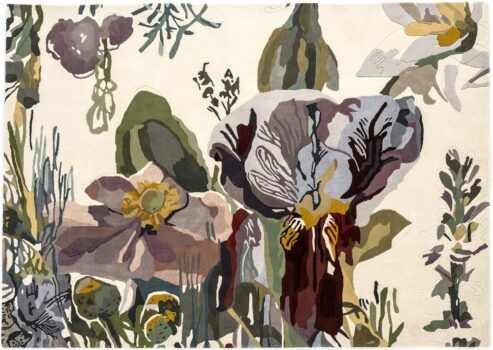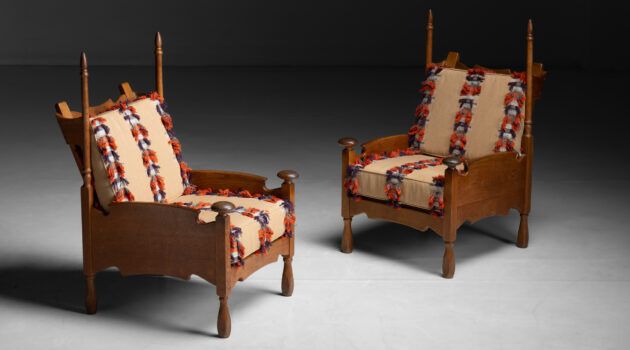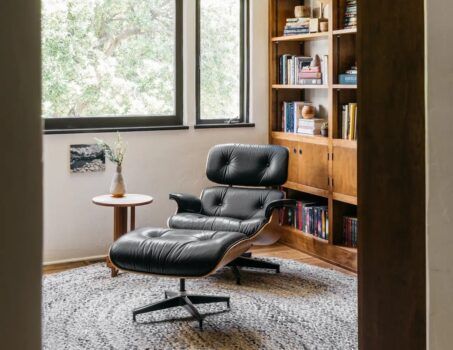Do You Speak Furniture in French?
Check your vocab skills with these French words from the worlds of decor, art and antiques.
1. Bois de rose
A. Rosewood
B. Tulipwood
C. Wood ornamented with carvings in the shape of roses and other floral varieties
D. A rare redwood whose core has a blush tone
2. Singerie
A. An 18th-century decorative motif representing a gathering of monkeys, generally dressed as humans and engaged in such activities as card playing, hunting or playing commedia dell’arte characters
B. A method of singing wood to produce decorative, burnished patterns, common in boiserie
C. An elaborate coatrack with arms that can be raised or lowered with levers
D. A painted motif, often found on 17th-century French porcelain, featuring maidens singing in small choral groups
3. Rocaille
A. A bassinet on rockers
B. A derogatory term for the Rococo style, coined by French philosophes who favored a more austere aesthetic
C. Rocks used for paving garden pathways
D. Rococo furniture ornamentation resembling a shell or the irregular shapes of garden rocks
4. Canapé
A. A soft wood of the genus Ulmus that occurs only in the tree canopy and is used in delicate bentwood furniture
B. An exotic rattan style imported to France from French Indochina
C. A 17th-century word for “tree swing”
D. An upholstered sofa
5. Tête-à-tête
A. Two mirrors angled slightly to face one another, a common feature of gentlemen’s dressing tables by Beau Brummel
B. A small S-shaped sofa in which the two curves of the S each hold a seat so that those sitting in them face opposite directions
C. Carved busts that cap both sides of a formal garden gate
D. A settee with a high back at either end
6. Huchier
A. A primitive form of a hutch, found in French peasant homes
B. An artisan who makes fine cabinets using the panel method
C. Delicate padding inside a baby’s cradle, whose French name is the root of the soothingly onomatopoeic English word “hushabye,” as in the song “Hushabye, baby, don’t you cry”
D. The earliest hand-operated spin dryer, developed in France in the 19th century
7. Chauffeuse
A. A step ladder designed to help a carriage driver, or chauffeur, and his passengers to step up into a high carriage
B. A chair with a very low seat, intended for sitting close to a fire
C. A type of wood known for its high burning temperature, which was used for wall paneling near the fireplace of French country houses
D. A stackable fireside shoe rack, short for chauffe-chaussettes
8. Ébéniste
A. An artisan specializing in wallpaper hanging
B. A very rare and endangered variety of ebony
C. A French cabinetmaker
D. An ottoman upholstered in ebony black to disguise the soot accumulated from woodburning fireplaces
9. Fauteuil voltaire
A. A particularly plush wingback armchair, often with gold-embroidered upholstery, common in the 18th century
B. A chair, used in the 18th century to sit at a high-angled writing desk, similar in style to one the French philosopher might have sat in
C. A 19th-century low-seated, upholstered armchair with a tall, scroll-topped back
D. A type of armchair that originated in the town of Airvault, where Voltaire’s family came from, and which is commonly thought to be the origin of the writer’s nom de plume
10. Cellarette
A. A cart used to transport goods from the cellar to the main house
B. A china cabinet with a glass front composed of small, cell-like window panes
C. A colored-glass box used to display jewelry
D. A small chest, usually of wood, used to store wine or liquor bottles
11. Églomisé
A. A term applied to a glass panel whose reverse has been painted or gilded in gold, white and blue
B. An adjective for walls to which paint incorporating gold leaf has been applied, producing a glowing effect
C. An adjective describing the colored glass found in the private chapels of French châteaus
D. A term used to describe any hardwood treated with an extremely shiny lacquer
12. Grisaille
A. A matte-finish paint, from the French word for “dull”
B. A painting in various gray shades, representing solid bodies in relief
C. The shocking, or “grisly,” gargoyle characters that are placed atop chicken coops to scare away predators
D. A smooth garden stone that represented the height of style in 17th-century France
Answers
- B. Tulipwood – Although it’s often confused with rosewood, the tree that yields tulipwood belongs to a totally different genus. True to its name, the Liriodendron tulipifera (or tulip poplar) produces a tulip-shaped flower and rose-tinted wood. In contrast, genuine rosewood belongs to the Dalbergia genus and is known for its red color and sweet smell.
- A. – Singerie first appeared in the work of Jean Bérain in the late 17th century and was especially popular in the following century. It often appears with chinoiserie motifs.
- D. – Originally used in reference to the rockwork in the artificial grottoes of Versailles, the term came to be applied to any furniture ornamentation that resembled shells or garden rocks. Commonly found in the phrase rocaille et coquille.
- D. – Although the term was used in the late 17th century to refer to a daybed, it was in the 18th century that the first true canapé appeared: a high-backed, somewhat formal piece that resembled a laterally extended fauteuil à la reine. There followed several variations on the form, including the marquise, designed for two people; the canapé à confidante, which had a seat at each end, facing outward; and the causeuse, which curves inward so that those sitting on it face each other.
- B. – Also known as a vis-a-vis or siamoise
- B. – The name comes from the fact that huchiers originally made special ornate wooden bread bins called huches.
- B. – The furniture form originated in the 17th century.
- C. – The craze for ebony in the early 17th century led master craftsmen, then called huchiers, to advertise their ability to work in this difficult wood. The word came to denote a master cabinetmaker of great skill.
- C. – The origin of this term is not clear, but since the design was developed decades after the French philosopher died, no direct connection can be drawn to him. It probably refers to the French origins of the form, adapted by American makers — most notably Duncan Phyfe — from similar Restoration-style pieces.
- D. – The box is either lined with metal and filled with ice as a wine cooler or, unlined, compartmented, and used to store wine and liquor bottles.
- A. – This decorative technique was popular in case furniture of the 18th and 19th centuries. The technique was used in glassware since ancient Roman times and was first applied to furniture in France at the height of the Louis XVI style, when it was made fashionable by a maker of mirrors and picture frames, Jean-Baptiste Glomy, after whom it is named.
- B. – A grisaille may be a painting in its own right or serve as an underpainting for oil or as an engraver’s model.




